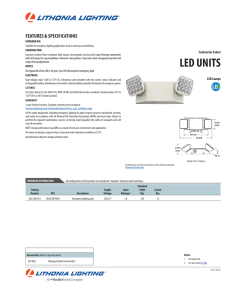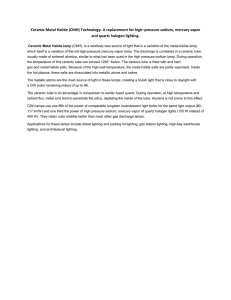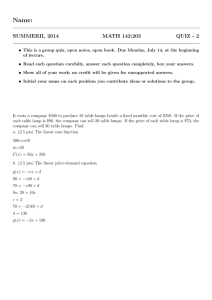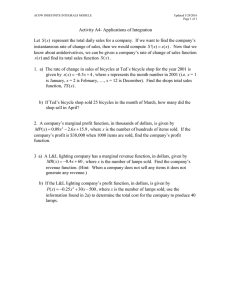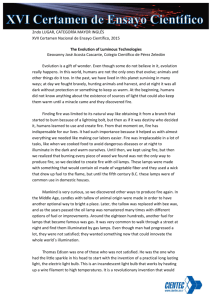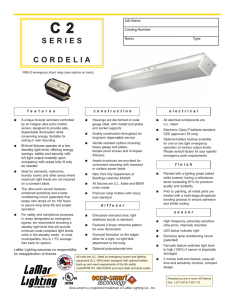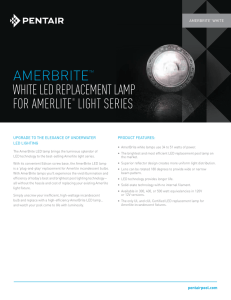Xing-er Lu General Electric Lighting COOPERATIVE EDUCATION PROGRAM CO-OP STUDENT REPORTS
advertisement
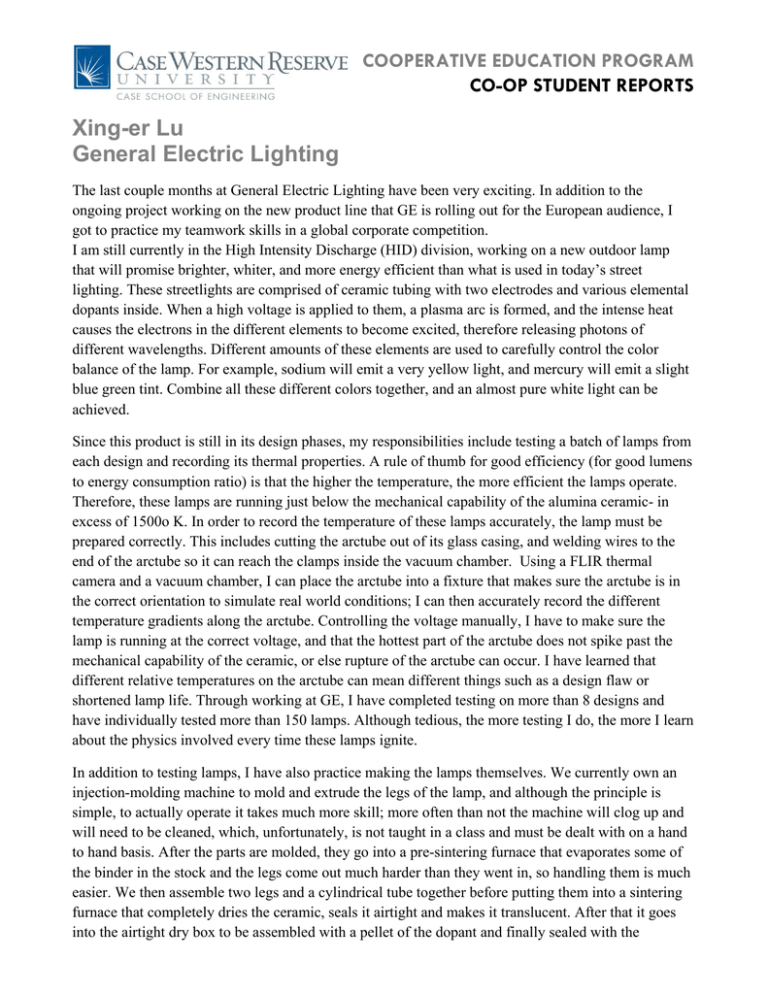
COOPERATIVE EDUCATION PROGRAM CO-OP STUDENT REPORTS Xing-er Lu General Electric Lighting The last couple months at General Electric Lighting have been very exciting. In addition to the ongoing project working on the new product line that GE is rolling out for the European audience, I got to practice my teamwork skills in a global corporate competition. I am still currently in the High Intensity Discharge (HID) division, working on a new outdoor lamp that will promise brighter, whiter, and more energy efficient than what is used in today’s street lighting. These streetlights are comprised of ceramic tubing with two electrodes and various elemental dopants inside. When a high voltage is applied to them, a plasma arc is formed, and the intense heat causes the electrons in the different elements to become excited, therefore releasing photons of different wavelengths. Different amounts of these elements are used to carefully control the color balance of the lamp. For example, sodium will emit a very yellow light, and mercury will emit a slight blue green tint. Combine all these different colors together, and an almost pure white light can be achieved. Since this product is still in its design phases, my responsibilities include testing a batch of lamps from each design and recording its thermal properties. A rule of thumb for good efficiency (for good lumens to energy consumption ratio) is that the higher the temperature, the more efficient the lamps operate. Therefore, these lamps are running just below the mechanical capability of the alumina ceramic- in excess of 1500o K. In order to record the temperature of these lamps accurately, the lamp must be prepared correctly. This includes cutting the arctube out of its glass casing, and welding wires to the end of the arctube so it can reach the clamps inside the vacuum chamber. Using a FLIR thermal camera and a vacuum chamber, I can place the arctube into a fixture that makes sure the arctube is in the correct orientation to simulate real world conditions; I can then accurately record the different temperature gradients along the arctube. Controlling the voltage manually, I have to make sure the lamp is running at the correct voltage, and that the hottest part of the arctube does not spike past the mechanical capability of the ceramic, or else rupture of the arctube can occur. I have learned that different relative temperatures on the arctube can mean different things such as a design flaw or shortened lamp life. Through working at GE, I have completed testing on more than 8 designs and have individually tested more than 150 lamps. Although tedious, the more testing I do, the more I learn about the physics involved every time these lamps ignite. In addition to testing lamps, I have also practice making the lamps themselves. We currently own an injection-molding machine to mold and extrude the legs of the lamp, and although the principle is simple, to actually operate it takes much more skill; more often than not the machine will clog up and will need to be cleaned, which, unfortunately, is not taught in a class and must be dealt with on a hand to hand basis. After the parts are molded, they go into a pre-sintering furnace that evaporates some of the binder in the stock and the legs come out much harder than they went in, so handling them is much easier. We then assemble two legs and a cylindrical tube together before putting them into a sintering furnace that completely dries the ceramic, seals it airtight and makes it translucent. After that it goes into the airtight dry box to be assembled with a pellet of the dopant and finally sealed with the electrodes. It can then be mounted and racked for burn testing. I have received training in all of these areas, including using two different X-ray machines to determine if the lamp dimensions were made to spec. In late May, I placed myself into a committee dedicated to making a promotional video for a corporate competition. This was a global competition that outlined the life of an intern at GE. We spent 2 months making the video, and through this process I learned to work with other interns, discuss problems and resolve them as a team. My role in this video was to work the camera, lighting, and the final edit for submission. Our video is roughly four minutes long and contained a “Mythbusters” theme- it contained three common “myths” that shroud the intern experience, which we promptly busted through intern interviews and visuals. Out of more than 70 submissions, we made the top 9 for final voting. Although we did not win, we felt that in making the top finalists, we really gave the Lighting division good exposure in the corporate world. I have received multiple emails and instant messages about interns in other parts of the world congratulating our team on making the video. It’s a very humbling experience and I’m very glad to have been part of it. This co-op experience is soon coming to a close and I cannot believe how fast the 8 months have gone by. Through the specialized training and real world engineering experience, I now have much higher hopes for my post graduation future.

